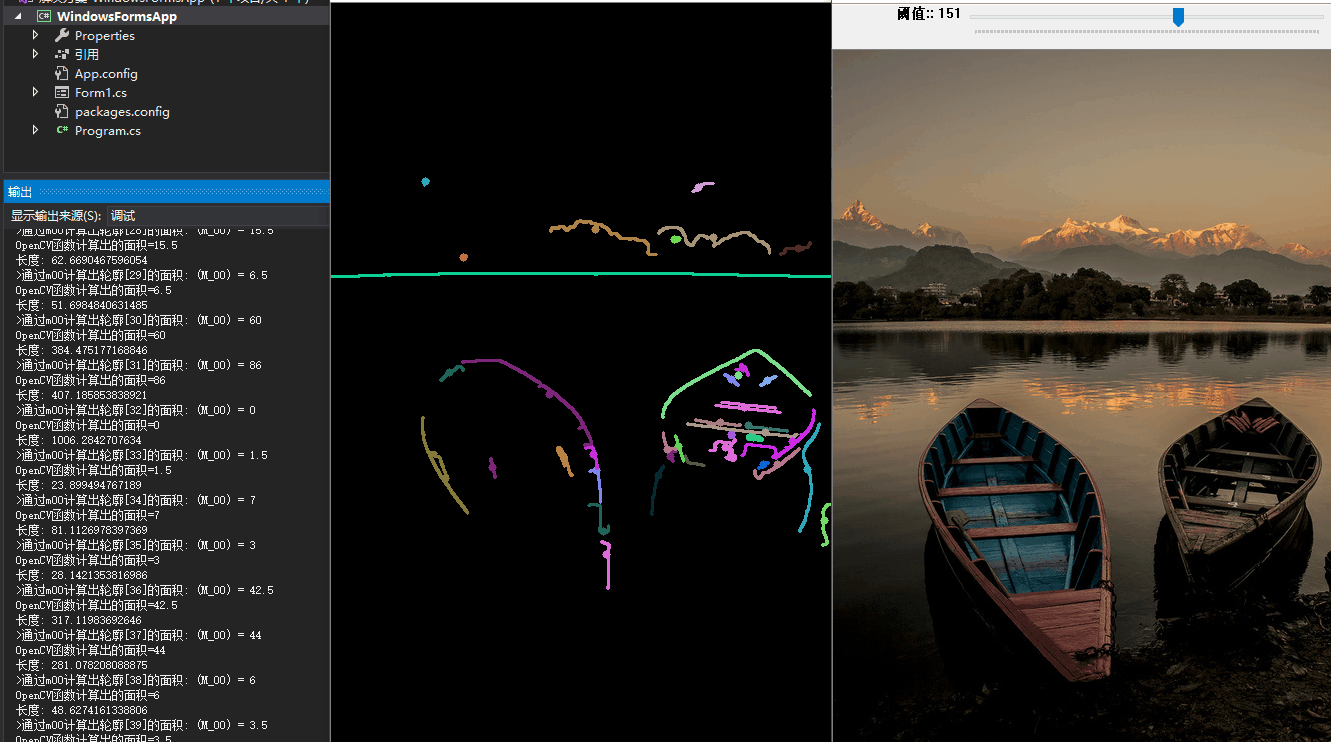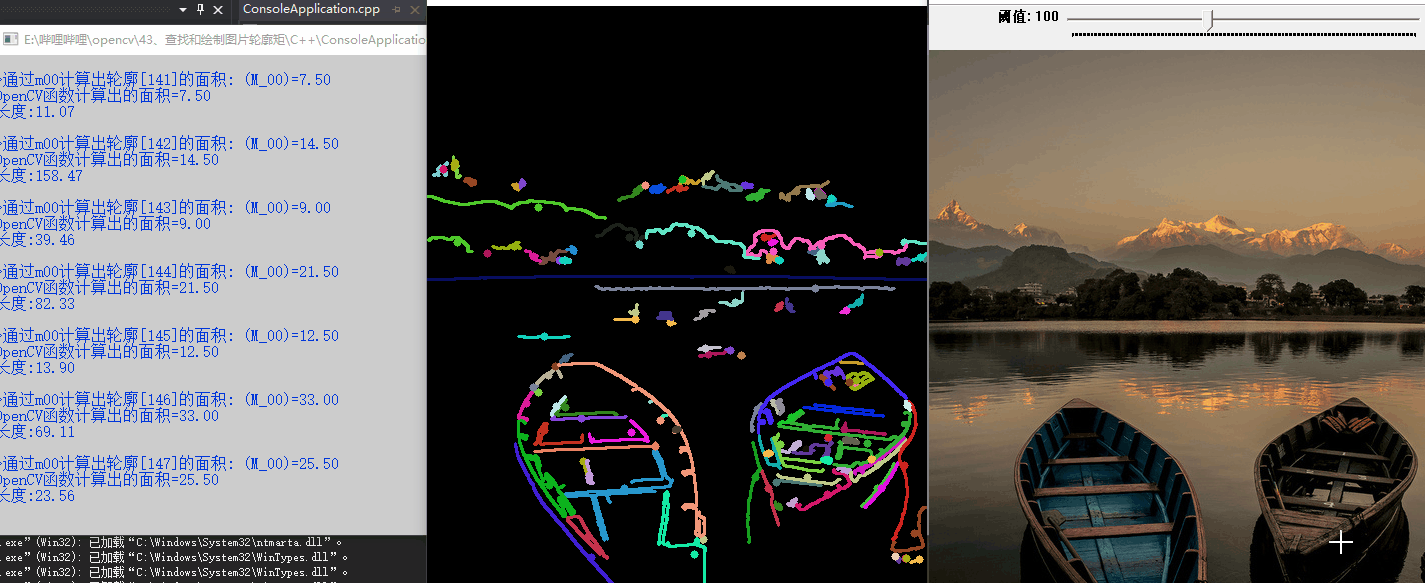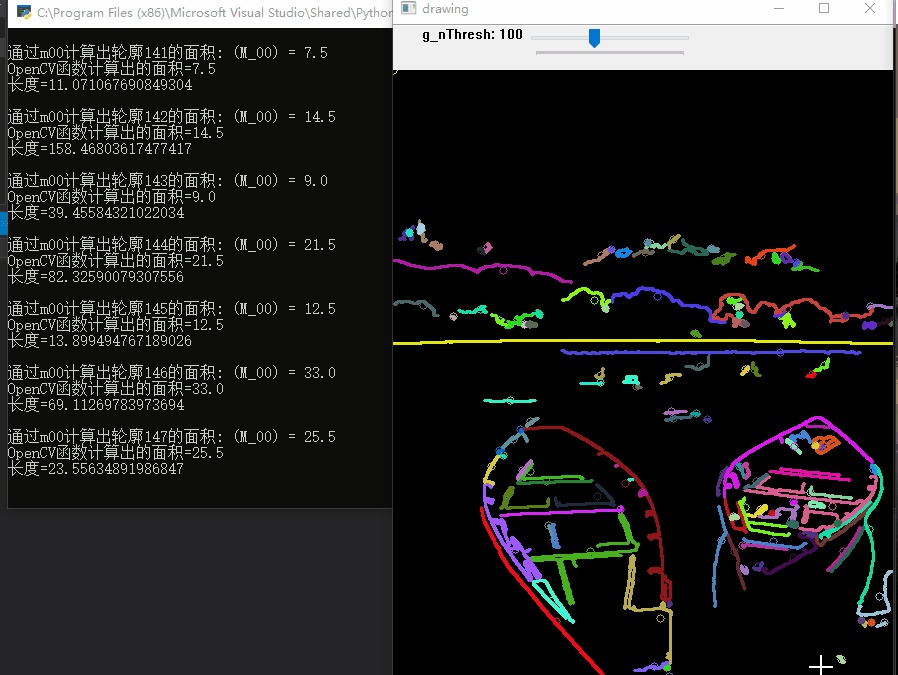查找和绘制图片轮廓矩
视频讲解如下:
在本章节中给大家演示如何查找和绘制图片的轮廓矩,当前代码同样的是在毛星云的代码基础上进行扩展优化的。
C#、C++、Python三种版本的效果其实是一样的,但我这里还是单独做了演示。
当前系列所有demo下载地址:
https://github.com/GaoRenBao/OpenCv4-Demo
不同编程语言对应的OpenCv版本以及开发环境信息如下:
语言 | OpenCv版本 | IDE |
C# | OpenCvSharp4.4.8.0.20230708 | Visual Studio 2022 |
C++ | OpenCv-4.5.5-vc14_vc15 | Visual Studio 2022 |
Python | OpenCv-Python (4.6.0.66) | PyCharm Community Edition 2022.1.3 |
首先呢,我们需要准备一张测试图片。(不想下载工程的童鞋,可直接复制下面的图片和代码)

C#的演示效果如下,左侧是计算结果的输出,中间是图像效果,右侧是滑动条窗口。

C#版本代码如下:
C#版本需要安装“OpenCvSharp4”、“OpenCvSharp4.runtime.win”两个库才行。不然会报错。
如果需要使用“ BitmapConverter.ToBitmap”操作,则需要追加安装“OpenCvSharp4.Extensions”库。
using OpenCvSharp;
using System;
using System.Collections.Generic;
namespace demo
{
internal class Program
{
static Mat g_cannyMat_output = new Mat();
static Mat g_grayImage = new Mat();
static int g_nThresh = 100;
static RNG rng = new RNG(12345);
static void Main(string[] args)
{
//【1】载入3通道的原图像
Mat src = Cv2.ImRead("../../../images/lake2.jpg");
if (src.Empty())
{
Console.WriteLine("Could not open or find the image!");
return;
}
//【2】得到原图的灰度图像并进行平滑
Cv2.CvtColor(src, g_grayImage, ColorConversionCodes.BGR2GRAY);
Cv2.Blur(g_grayImage, g_grayImage, new Size(3, 3));
//【3】创建原始图窗口并显示
Cv2.NamedWindow("Source", WindowFlags.AutoSize);
Cv2.ImShow("Source", src);
//【4】设置滚动条并调用一次回调函数
Cv2.CreateTrackbar("阈值:", "Source", ref g_nThresh, 255, thresh_callback);
thresh_callback(0, IntPtr.Zero);
Cv2.WaitKey();
}
private static void thresh_callback(int pos, IntPtr userData)
{
// 使用Canndy检测边缘
Cv2.Canny(g_grayImage, g_cannyMat_output, g_nThresh, g_nThresh * 2, 3);
// 找出轮廓
Point[][] g_vContours;
HierarchyIndex[] g_vHierarchy;
Cv2.FindContours(g_cannyMat_output, out g_vContours, out g_vHierarchy, RetrievalModes.Tree, ContourApproximationModes.ApproxSimple);
// 计算矩
List<Moments> mu = new List<Moments>();
for (int i = 0; i < g_vContours.Length; i++)
{
mu.Add(Cv2.Moments(g_vContours[i], false));
}
// 计算中心矩
List<Point> mc = new List<Point>();
for (int i = 0; i < g_vContours.Length; i++)
{
mc.Add(new Point((float)(mu[i].M10 / mu[i].M00), (float)(mu[i].M01 / mu[i].M00)));
}
// 绘制轮廓
Mat drawing = Mat.Zeros(g_cannyMat_output.Size(), MatType.CV_8UC3);
for (int i = 0; i < g_vContours.Length; i++)
{
// 随机设置颜色
Scalar color = new Scalar(rng.Uniform(0, 255), rng.Uniform(0, 255), rng.Uniform(0, 255));
// 绘制外层和内层轮廓
Cv2.DrawContours(drawing, g_vContours, (int)i, color, 2, LineTypes.Link8, g_vHierarchy, 0, new Point());
//绘制圆
Cv2.Circle(drawing, mc[i], 4, color, -1, LineTypes.Link8, 0);
}
// 通过m00计算轮廓面积并且和OpenCV函数比较
System.Diagnostics.Debug.WriteLine("\t输出内容: 面积和轮廓长度\n");
for (int i = 0; i < g_vContours.Length; i++)
{
System.Diagnostics.Debug.WriteLine($">通过m00计算出轮廓[{i}]的面积: (M_00) = {mu[i].M00}");
System.Diagnostics.Debug.WriteLine($"OpenCV函数计算出的面积={Cv2.ContourArea(g_vContours[i])}");
System.Diagnostics.Debug.WriteLine($"长度: {Cv2.ArcLength(g_vContours[i], true)}");
Scalar color = new Scalar(rng.Uniform(0, 255), rng.Uniform(0, 255), rng.Uniform(0, 255));
Cv2.DrawContours(drawing, g_vContours, i, color, 2, LineTypes.Link8, g_vHierarchy, 0, new Point());
Cv2.Circle(drawing, mc[i], 4, color, -1, LineTypes.Link8, 0);
}
Cv2.ImShow("Contours", drawing);
}
}
}
C++的演示效果如下,左侧是计算结果的输出,中间是图像效果,右侧是滑动条窗口。

C++版本代码如下:
#include "opencv2/highgui/highgui.hpp"
#include "opencv2/imgproc/imgproc.hpp"
#include <iostream>
using namespace cv;
using namespace std;
#define WINDOW_NAME1 "【原始图】" //为窗口标题定义的宏
#define WINDOW_NAME2 "【图像轮廓】" //为窗口标题定义的宏
Mat g_srcImage; Mat g_grayImage;
int g_nThresh = 100;
int g_nMaxThresh = 255;
RNG g_rng(12345);
Mat g_cannyMat_output;
vector<vector<Point> > g_vContours;
vector<Vec4i> g_vHierarchy;
void on_ThreshChange(int, void*)
{
// 使用Canndy检测边缘
Canny(g_grayImage, g_cannyMat_output, g_nThresh, g_nThresh * 2, 3);
// 找到轮廓
findContours(g_cannyMat_output, g_vContours, g_vHierarchy, RETR_TREE, CHAIN_APPROX_SIMPLE, Point(0, 0));
// 计算矩
vector<Moments> mu(g_vContours.size());
for (unsigned int i = 0; i < g_vContours.size(); i++)
{
mu[i] = moments(g_vContours[i], false);
}
// 计算中心矩
vector<Point2f> mc(g_vContours.size());
for (unsigned int i = 0; i < g_vContours.size(); i++)
{
mc[i] = Point2f(static_cast<float>(mu[i].m10 / mu[i].m00), static_cast<float>(mu[i].m01 / mu[i].m00));
}
// 绘制轮廓
Mat drawing = Mat::zeros(g_cannyMat_output.size(), CV_8UC3);
for (unsigned int i = 0; i < g_vContours.size(); i++)
{
Scalar color = Scalar(g_rng.uniform(0, 255), g_rng.uniform(0, 255), g_rng.uniform(0, 255));//随机生成颜色值
drawContours(drawing, g_vContours, i, color, 2, 8, g_vHierarchy, 0, Point());//绘制外层和内层轮廓
circle(drawing, mc[i], 4, color, -1, 8, 0);;//绘制圆
}
// 显示到窗口中
namedWindow(WINDOW_NAME2, WINDOW_AUTOSIZE);
imshow(WINDOW_NAME2, drawing);
// 通过m00计算轮廓面积并且和OpenCV函数比较
printf("\t 输出内容: 面积和轮廓长度\n");
for (unsigned int i = 0; i < g_vContours.size(); i++)
{
printf(">通过m00计算出轮廓[%d]的面积: (M_00)=%.2f\n", i, mu[i].m00);
printf("OpenCV函数计算出的面积=%.2f\n", contourArea(g_vContours[i]));
printf("长度:%.2f\n\n", arcLength(g_vContours[i], true));
Scalar color = Scalar(g_rng.uniform(0, 255), g_rng.uniform(0, 255), g_rng.uniform(0, 255));
drawContours(drawing, g_vContours, i, color, 2, 8, g_vHierarchy, 0, Point());
circle(drawing, mc[i], 4, color, -1, 8, 0);
}
}
int main(int argc, char** argv)
{
//【0】改变console字体颜色
system("color 71");
// 读入原图像, 返回3通道图像数据
g_srcImage = imread("../images/lake2.jpg", 1);
// 把原图像转化成灰度图像并进行平滑
cvtColor(g_srcImage, g_grayImage, COLOR_BGR2GRAY);
blur(g_grayImage, g_grayImage, Size(3, 3));
// 创建新窗口
namedWindow(WINDOW_NAME1, WINDOW_AUTOSIZE);
imshow(WINDOW_NAME1, g_srcImage);
//创建滚动条并进行初始化
createTrackbar(" 阈值", WINDOW_NAME1, &g_nThresh, g_nMaxThresh, on_ThreshChange);
on_ThreshChange(0, 0);
waitKey(0);
return(0);
}
Python的演示效果如下,左侧是计算结果的输出,右侧是图像效果和滑动条窗口。

Python版本代码如下:
import cv2
import numpy as np
import random
g_nThresh = 100
def on_ThreshChange(x):
global g_nThresh, g_grayImage, drawing
# 获取滑动条的值
g_nThresh = cv2.getTrackbarPos('g_nThresh', 'drawing')
g_cannyMat_output=cv2.Canny(g_grayImage,g_nThresh,g_nThresh*2,3)
# 找出轮廓
g_vContours, g_vHierarchy = cv2.findContours(g_cannyMat_output,cv2.RETR_TREE,cv2.CHAIN_APPROX_SIMPLE)
# 计算矩
mu = []
for i in range(len(g_vContours)):
mu.append(cv2.moments(g_vContours[i]))
# 计算中心矩
mc = []
for i in range(len(g_vContours)):
if mu[i]['m00'] != 0 :
mc.append((int(mu[i]['m10'] / mu[i]['m00']), int(mu[i]['m01'] / mu[i]['m00'])))
else:
mc.append((0, 0))
# 绘制轮廓
drawing = np.zeros((g_cannyMat_output.shape[0], g_cannyMat_output.shape[1], 3), np.uint8)
for i in range(len(g_vContours)):
# 随机设置颜色
color = (random.randint(0,255), random.randint(0,255), random.randint(0,255))
# 绘制外层和内层轮廓
cv2.drawContours(drawing, g_vContours, i, color, 2, 8, g_vHierarchy, 0)
# 绘制圆
cv2.circle(drawing, mc[i], 4, color ,1, 8, 0)
print("输出内容: 面积和轮廓长度")
for i in range(len(g_vContours)):
# 随机设置颜色
color = (random.randint(0,255), random.randint(0,255), random.randint(0,255))
print("通过m00计算出轮廓" + str(i) + "的面积: (M_00) = " + str(mu[i]["m00"]))
print("OpenCV函数计算出的面积=" + str(cv2.contourArea(g_vContours[i])))
print("长度=" + str(cv2.arcLength(g_vContours[i], True)) + "\n")
cv2.drawContours(drawing, g_vContours, i, color, 2, 8, g_vHierarchy, 0)
cv2.circle(drawing, mc[i], 4, color ,1, 8, 0)
# 载入3通道的原图像
g_srcImage = cv2.imread("../images/lake2.jpg")
# 得到原图的灰度图像并进行平滑
g_grayImage = cv2.cvtColor(g_srcImage, cv2.COLOR_BGR2GRAY)
# 均值滤波
g_grayImage = cv2.blur(g_grayImage, (3,3))
cv2.imshow("g_srcImage", g_srcImage)
# 初始化一个空白图像
drawing = np.zeros((g_grayImage.shape[0], g_grayImage.shape[1], 3), np.uint8)
# 创建窗口
cv2.namedWindow('drawing')
cv2.createTrackbar('g_nThresh', 'drawing', 0, 255, on_ThreshChange)
cv2.setTrackbarPos('g_nThresh', 'drawing', 100)
while (True):
cv2.imshow("drawing", drawing)
if cv2.waitKey(10) == ord('q'):
break
cv2.destroyAllWindows()







